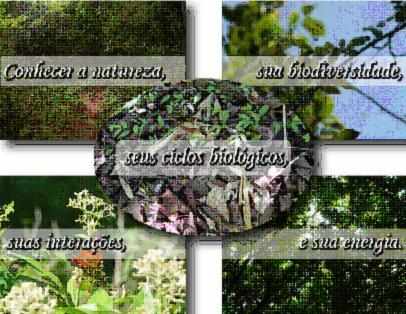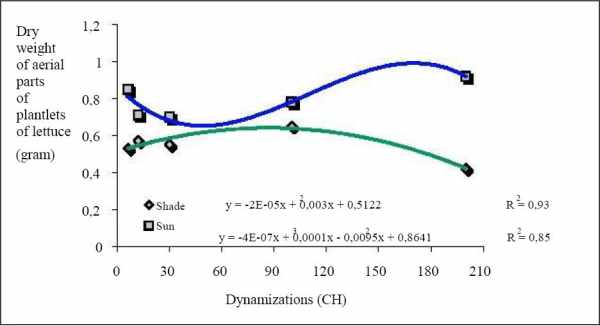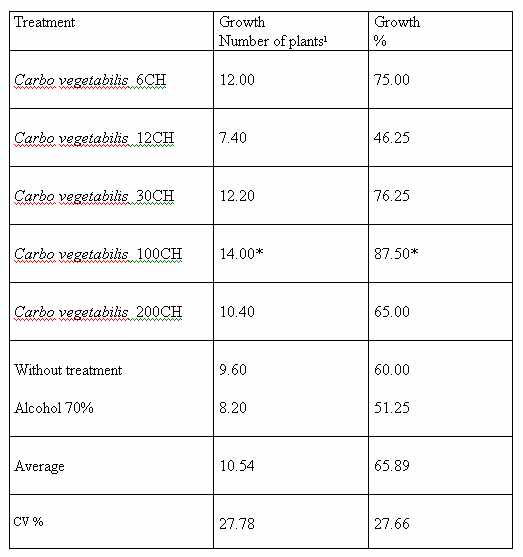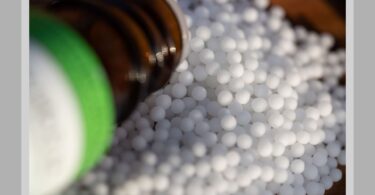Agro-Homeopathy is one of the sciences based on vitalism and on agro-ecological principles, dedicated to understanding nature, it’s biodiversity, biological cycles and interactions, and principally it’s vital energy (Fig. 1). Vitalistic agriculture is the application of agro-ecological basics and the vital force or principle which rules nature. It is employed in the organization of the agro-ecosystem, and is used in the production of healthy food within a dynamic equilibrium. This agricultural perspective comprehends the principle of life and death (vital energy) and thereby knows that both states of the material concept are essential for a productive system with low energetic costs. (ROSSI, 2005).
Fig. 1 – Conception of nature for the practice of vitalistic agriculture.
The vital force is defined as the unity of action which rules physical life, conferring it with its own sensations and responses. This principle is dynamic, immaterial, differs from body and soul, and integrates the totality of the organism, organizing all its physiological phenomena. In this manner, the imbalanced vital force produces manifestations such as physical, emotional and mental symptoms, which we call disease. In the state of health the parts of the organism are maintained in harmony or balance. Agro-homeopathy is a tool to re-establish homeostasis of the systems of the plant, that is to say, of an agro-ecosystem in dynamic equilibrium.
The application of homeopathy by agricultural engineers was legalized in Brazil by means of organic agriculture. On the 17th May 1999, the Rule no. 007 was published in the Official Diary of the Union by the Agriculture Secretary, embracing products denominated as organic, ecological, biodynamic, natural, sustainable, regenerative, biological, agro-ecological as well as permaculture. It includes measures about environmental and human health, and was intended to secure clarity in all steps of production and transformation (BRAZIL, 1999). The rules recommend homeopathy for the control of plagues and diseases. In Brazil, research on homeopathy for plants centers on verifying its influence on the morphology and physiology of plants and determining which compounds of the primary and secondary metabolism are altered with the application of medicines. Also, the productive characteristics were evaluated and the response or resistance towards adverse environmental conditions, like climate, the attack of insect plagues and pathogens, and moreover the effects on the soil.
Homeopathic experiments with plants began in 2002 in the Regional Pole of Technological Development of Agro-Business Centro-Sur, of the Agency Paulista of Agro-business Technology (APTA). They were able to verify in experiments with lettuce that the homeopathic preparation of Carbo vegetabilis 30CH, applied every 48 hours, increased the dry weight of lettuce by 22% in relation to the control group (ROSSI et al., 2003). In the experiment with tomato plants the biopreparations of Xanthomonas campestris efficiently reduced the severity of the disease; the medicine in dynamizations of 24CH and 6CH was applied through irrigation (ROSSI et al., 2004c). The application of the homeopathic remedy Phosphorus 100CH raised the proportions of zinc and boron in the soil when organic manure was applied (ROSSI et al., 2004b). In strawberry plants the homeopathic preparation of Carbo vegetabilis 30CH increased the reproduction of plantlets in relation to the control group treated with 70% alcohol.
This remedy was responsible for the lower commercial production of strawberry fruits, proof that this substance acts in favor of the vegetative development of the plant (production of plantlets) (ROSSI, 2005). The homeopathic remedy Carbo vegetabilis was probed in lettuce using the Hahnemannian Centesimal potencies (CH) 6, 12, 30, 100 and 200, with two control groups, one of 70% alcohol (vehicle for the preparation of medicines), and an absolute control group (without the application of substances) (ROSSI, 2005). There was the tendency towards a wave-like response (polynomial regression of 3rd order) in plantlets produced in normal environment, in which some dynamizations increased the values of measured variables, whereas others demonstrated a suppressive effect (image 2).
Fig. 2 – Dry weight of the aerial parts of plantlets of lettuce 28 DAP produced in the shade house and in a greenhouse, treated with varying dynamizations (CH) of the homeopathic remedy Carbo vegetabilis.
The point of inflection in the curve demonstrates the dynamization at which point the equilibrium is accomplished, and which also corresponds to the maximum value of analyzed variables from plantlets produced in a stressful environment. In a shady environment, the dry weight of the aerial parts, as well as the growth of the root system, demonstrate that the potency 100CH was responsible for equilibrating the plantlets produced in the stressful environment. This was also evident on account of the increased quantity of plants growing on the land 15 days after transplantation (Table 1).
Table 1 – Quantity of plants growing on the land 15 days after transplantation, from plantlets produced in the shade house.
* Difference from the control group (70% alcohol) as evaluated by the Dunnett’s test (p<0,05).
The special nature of homeopathic remedies testifies that the living organism possesses subtle unities difficult to explain by modern scientific knowledge. The veracity of effects of homeopathic medicines is confirmed daily in clinical practice, denoting that the living organism is currently the one and only thing capable of confirming the said dynamic action. The ability of homeopathic remedies to cause changes in animals, plants and the soil, confirms that these effects are not due to psychological effects (placebo). The results obtained are undeniable, therefore, we can expect over the next century, a further comprehension of the therapeutic mechanisms of homeopathy (CORREA et al., 1997). The investigations with plants will contribute to the expansion and consolidation/implementation of homeopathy (ROSSI, 2004a).
References
BRASIL. Instrução normativa no7, de 17 de maio de 1999. Dispõe sobre as normas para a produção de produtos orgânicos vegetais e animais. Diário Oficial da República Federal do Brasil, BrasÃlia, v.99, n.94, p.11-14, 19 de maio de 1999. (Seção 1).
CORREA, A.D.; SIQUEIRA-BATISTA, R; QUINTAS, L.E.M. Similia Similibus Curentur: notação histórica da medicina homeopática. Revista da Associação Médica do Brasil, São
Paulo, v.43, n.4, p.347-351, 1997.
ROSSI, F. Aplicação de preparados homeopáticos em morango e alface visando o cultivo com base agroecológica. Dissertação (Mestrado em Fitotecnia) Escola Superior de Agricultura Luiz de Queiroz, Piracicaba-SP, 2005. 79p.
ROSSI, F.; AMBROSANO, E.J.; MELO, P.C.T.; GUIRADO, N.; MENDES, P.C.D. Experiências básicas de homeopatia em vegetais. Revista Cultura Homeopática, São Paulo, n.7, v.3, p.12-13, 2004a.
ROSSI, F.; AMBROSANO, E. J.; GUIRADO, N.; AMBROSANO, G. M. B.; MENDES, P. C. D.; MELO, P.C.T.; BELTRAME, K. G. Alterações nas caracterÃsticas quÃmicas de dois solos submetidos a adubação mineral e orgânica, aplicados juntos ou separadamente, e a associação orgânica e homeopatia (Phosphorus CH100). In: FERTBIO, 2004, Lages, Anais… Lages:
Sociedade Brasileira de Ciência do Solo. 2004b. 1CD-ROM.
ROSSI, F.; MELO, P.C.T.; PASCHOLATI, S.F.; CASALI, V.W.D.; AMBROSANO, E.J.; GUIRADO, N.; MENDES, P.C.D.; AMBROSANO, G.M.B.; SCHAMMASS, E.A.; TOFFANO,
L.; DI PIERO, R.M. Aplicação de bioterápico visando induzir resistência em tomateiro contra mancha bacteriana. In: CONGRESSO BRASILEIRO DE AGROECOLOGIA, 2. 2004, Anais… Porto alegre: EMATER-RS, 2004c. 1 CD-ROM
ROSSI, F; AMBROSANO, E.J.; GUIRADO, N.; AMBROSANO, G.M.B.; CASALI, V.W. D.; TESSARIOLI NETO, J.; MELO, P. C. T.; ARENALES, M. C.; SCHAMMASS, E. Aplicação de solução homeopática Carbo vegetabilis e produtividade da alface. In: CONGRESSO BRASILEIRO DE OLERICULTURA, 43, 2003, Recife. 2003. Horticultura Brasileira, BrasÃlia, v.21, n.2. 1CD-ROM
————————————
FabrÃcio Rossi1,2; Edmilson José Ambrosano1; Nivaldo Guirado1; Paulo César Tavares de Melo2
1 – APTA, Pólo Centro-Sul, Piracicaba- SP, CEP: 13400-970, Cx Postal 28.;
2 – ESALQ, Departamento de Fitotecnia, Piracicaba-SP, CEP: 13418-970, Cx. Postal 09









Kindly post me information on Homeopathy in agriculture plantwise.
Kindly regular news and information.
Tks